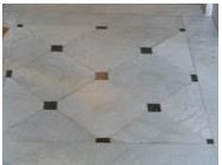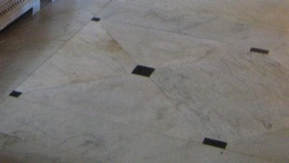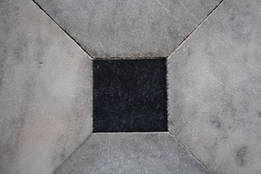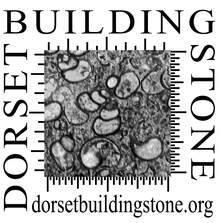Carboniferous Limestones: Polished Black (Lead author: PJB)
Carboniferous Limestone is a collective term for the succession of limestones occurring widely throughout Great Britain, Ireland, France and Belgium that were deposited during the Dinantian Epoch of the Carboniferous Period. These rocks formed between 363 and 325 million years ago. Within England and Wales, the entire limestone succession, which includes subordinate mudstones and some thin sandstones, is known as the Carboniferous Limestone Supergroup. (Wikipedia)
|
Polished black Carboniferous limestones tend to be very well cemented, very fine- grained and unsurprisingly perhaps, this stone's matrix can be very organically coloured black, the same as coal. Concentration of organic micro-crystalline calcite and absence of shelly detritus in the synclinal sea beds of these deposits accounts for the usual uniform blackness and absence of much whiter, more macro-crystalline sparite from developing during subsequent diagenesis and whereby shell and bone detritus changes to sparitic fossils. Veining tends to be rare and very fine. The best known black polished limestone, in longest and widest European commercial use, has been the 'Belgian Black' from around Tournai, on the Scheldt river, in Hainault province. It takes the very best reflective and translucent hand polish. Used locally from at least the 11th century, it was shipped post Norman conquest here ready for site masons to fit. This stone became one of the most expensive and prestigious decorative stones typical of imported Romanesque fonts and stone ledger slabs. Norman use was concentrated in cathedrals and in the churches of Essex and Kent.
|
Pre-carved angular, bowls and bases, with turned stem and shafts made to order, were shipped up English rivers virtually as flat-packed kits ready to be mortared together. In Dorset the high status Purbeck Marble was the preferred alternative for this style of font and also for ledger slabs, first by prominent clergy and then the gentry. The blackest of black stones were a "high fashion item" in the 18th century. Always very dangerous to mine and to carve, 'Tournai Black' remained for centuries the most elite, translucent black and reliably shiniest of any available black marble. Very inclined to break with a conchoidal fracture at the edges, like black flint or even glass, this stone nevertheless was sculpted to very fine detail that resists any accidental abrasion. The blackest of competing Carboniferous stones can be polished to a similar standard and be virtually impossible to tell apart without paperwork of the time. Additionally, from the 18th century, black and white chequerboard stone tiled flooring, became the most common use for polished Carboniferous limestone in Dorset, as elsewhere and there were now real choices of price and provenance.
|
Main hallway Kingston Lacy House: economised Belgian Black & large clouded graphite Carrara marble floor tiles.
By kind permission of the National Trust
By kind permission of the National Trust
|
From the 17th century, when Dinant was in French territory, similar polished black, invariably almost fossil and vein free but geologically older Devonian limestone, was sourced here for Versailles flooring by Louis XIV. This Devonian limestone from the Meuse was also elaborately sculpted and polished before the French Revolution for the elites of Europe and is still traded today by Marc Maison, Paris. (- see website.) This now most fashionable stone from Dinant, Mazy and Gozinne along the River Meuse in Namur, became together with the Tournai Black from Hainault as 'Belgian Black’. However, the 'Meuse Black' unlike the Tournai stone normally contains a high density of virtually invisible foraminifera microfossils almost too small for the eye to see and normally revealed only in rock thin section. (- see Stormyr et al below and the Skinner tomb at Winterborne Stickland.)Very well-known Carboniferous Ashford black from Derbyshire, was long known to the London “true black stone” market but apart from localised use by Chatsworth and neighbouring prestige properties the Ashford black was mostly used for candlesticks, vases, and backings to pietra dura inlay work, tables, ornaments, memorials and souvenirs. It had a reputation for discolouring in direct sunlight following use in columns at Chatsworth House, which seems to have become a competitive disadvantage. Nevertheless, columns and decorative fire places adorn other grand houses in that area and thick slabs to 7ft x 4ft were achieved from
|
Arrock quarry though under 40ft of overburden, so marketing large dimensional stone would have been very wasteful against the traditional vast range of smaller scale ornamental craft work that employed vast numbers of cottage workers. (see Ashford Black Marble link.) British Carboniferous polished blacks also included 'Stanhope black'; widely used for centuries in the Weardale area and similarly 'Manx marble’ now only available as 'Pooil black’.
Other than at Versailles and Westminster Abbey, black marble slabs have become extensively used for fashionable decorative chequerboard flooring from the 18th to 20th century in both mansions and significant public buildings. The worldwide commercial stone trade has long supplied Belgian Black for this purpose and hence determining any example’s exact provenance is rarely achieved. (see Norway link below.) Neither paleontologists nor petrologists ,even at great expense and by taking samples, can 100% reliably differentiate between the commercial polished black limestones nor determine their provenance. Belgian Black has had few large-scale commercial competitors and remains expensive because it is always hazardously mined. Many black and white chequerboard flooring designs have the white Carrara marble in large tiles and the Belgian black in a quarter or less of that size - for beyond good taste - economy. |
|
For chequerboard floorings economies were always available. White marbles when veined or clouded by graphite are cheaper than statuary stone and other predominantly black limestones, have always been very much cheaper. Irish Carboniferous limestones: Galway Black and Kilkenny Black, along with Kilkenny blue from Southern counties of the Republic have their own historic story as local building stone, polished flooring and for wider decorative stone use on the London market. The relatively rare Irish true blacks have been well worked out over time with only one such Kilkenny quarry remaining open. Wells Cathedral had Black Kilkenny columns installed in 1869. Kilkenny blue, a dark blue to almost true black is known in Dorset, see Winterborne Stickland and apart from the occasional white sparite in shells or veining, is still internationally available.
|
Very significantly the sea bed basins of many Irish deposits were rarely fully fossil free and include very sparitic coral, crinoidal, brachiopod and gastropod shell. So we can and do have both rare true black and shelly black Carboniferous limestones in Dorset. Shell in black Carboniferous may be almost absent, most rare, or for Kilkenny often plentiful. Wimborne Minster, Sturminster Marshall, Lytchett Matravers and Winterborne Stickland have examples of Carboniferous limestone polished black.
In Dorset when stained or polished black, early Jurassic Blue Lias with or without broken shell, has been much used for inscribed tomb ledgers and chequerboard flooring instead of the far more expensive black imports. Most Carboniferous black limestones contain corals but any presence of corals; micro or macro, precludes any stone being Blue Lias. Both Belgian black and Kilkenny shelly black are seen at St.Mary, Winterborne Stickland. |
Links
1) Belgium black marbles website
2) Information about the Belgian Dinantian (early Carboniferous)
3) Belgian Black C.12th. tombstone via London to Norway
4) Ashford Black Marble
5) Galway Black Marbles - not in current production
6) Irish Black Kilkenny Black Marble - Hardings Stoneyard Butler’s Grove
7) Irish Blue Marble Cl on varieties. or Search images Kilkenny blue limestone.
8) Stanhope Black Marble
9) Manx Marble/Pooil Black and Pooil Vaaish Ltd.
1) Belgium black marbles website
2) Information about the Belgian Dinantian (early Carboniferous)
3) Belgian Black C.12th. tombstone via London to Norway
4) Ashford Black Marble
5) Galway Black Marbles - not in current production
6) Irish Black Kilkenny Black Marble - Hardings Stoneyard Butler’s Grove
7) Irish Blue Marble Cl on varieties. or Search images Kilkenny blue limestone.
8) Stanhope Black Marble
9) Manx Marble/Pooil Black and Pooil Vaaish Ltd.
N.B. Named dimensional stone and named quarries have always been only intermittently in production - so provenance is rarely ever 100%. PJB,Feb.2018




